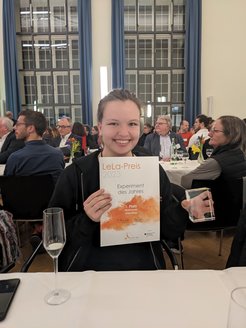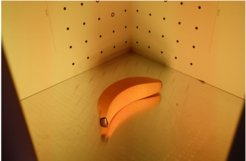The MPQ student lab wins a Lela Prize
For the fourth year in a row, the MPQ student lab has won a LeLa award. This year, it achieved first place in the category "Experiment of the Year".
With the experiment “Lecker im Licht” ("Delicious in the Light"), the school laboratory at the Max Planck Institute of Quantum Optics, has won the first prize of LernortLabor, the federal association of school laboratories. The interactive course explains the physics of light and the psychology behind lighting strategies.

Light, whether from the sun or artificial, affects our moods. With the right lighting, apples and tomatoes on the shelves look particularly juicy and fresh. The bananas shine in pristine yellow and the meat looks particularly tasty. It's all a question of lighting.
What this looks like in reality and the underlying physical science are the subjects of a new experiment that pupils (from grade 9) can find out about at Photonlab, the student laboratory at the Max Planck Institute for Quantum Optics. "Lecker im Licht" explains both the phenomena of light and the psychology behind lighting and colour vision. Colour vision makes up a large part of our sensory impressions. But it is subjective. It differs from creature to creature and can be deliberately manipulated. This is another aspect that the Photonlab team demonstrates in this course.

First of all, the theoretical concepts: with an interactive book in H5P as part of a "Flipped Classroom", the students work their way into the physical, biological, and physiological concepts of colour vision (https://photonlab.h5p.com/content/1291799541021602007). The physical part addresses the concepts of spectrum, colour, reflection, reflectivity and colour temperature; and in the section on biology, pupils learn about the parameters of colour perception. For example, why does a red apple appear red?
But nothing is more exciting than experimenting and trying things out yourself. "Lecker im Licht" contains three experiments that can be carried out independently. First, the young researchers familiarise themselves with the hand spectrometer to see that different light sources emit different spectra. In another experiment, they illuminate different types of fruit and vegetables with different colours. Careful observation shows that the perception of colour depends on the light source as well as on the illuminated object and its reflectivity - and on our eye. And exactly this, the eye and its sentsitivity of brightness are the subjects of the third experiment.
"The experiment set-up is very simple. Besides a dark box, all you need are test objects to illuminate, a power meter or photometer and a lux meter, which are available in specialised shops. We also built an LED light mixer ourselves," explains Sofie Silbermann, who designed the experiment and the supplementary teaching materials.
With the "Lecker im Licht" experiment, the Photonlab team has once again won a prize from LernortLabor, the federal association of school laboratories. "We are thrilled about the prize," says Silke Stähler-Schöpf. "Many thanks to everyone who helped with the realisation!"













